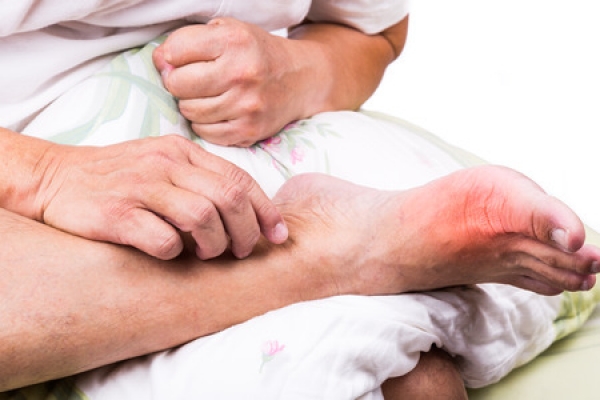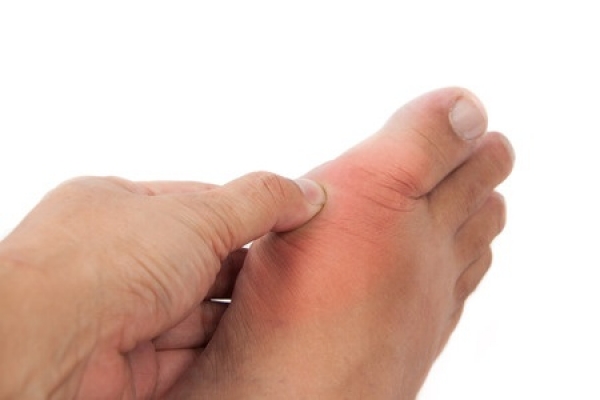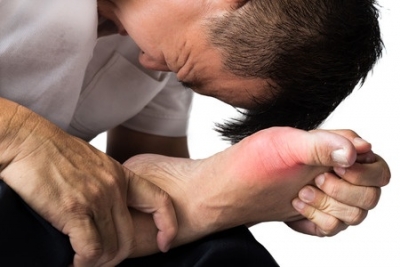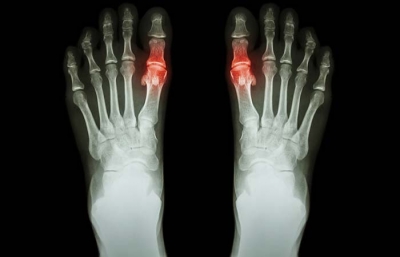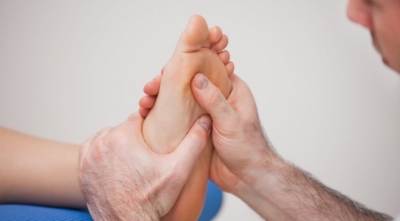Connect With Us
Blogs

Gout (5)
It’s beginning to look a lot like gout season here in the Douglas Park/Los Angeles County area and we at Superior Foot & Ankle Care Center want to help our patients learn more about this condition and how to avoid it.
Gout is a form of arthritis—in fact, it is sometimes referred to as gouty arthritis. This condition occurs as the result of a buildup of uric acid in the body, which then crystallizes in the joints causing extreme pain, throbbing, burning and tenderness in a joint, stiffness and decreased range of motion. Uric acid is a byproduct of the breakdown of purines, a chemical that is found naturally in the body and in certain foods. Risk factors for developing gout include:
- An inherited tendency for gout
- Obesity
- High blood pressure
- Diabetes
- Chemotherapy
- Recent surgery
- Stress
- Certain medication and vitamins
Although gout can strike men and women at any age, it is most commonly seen in men ages 40 to 60.
Why Now?
You may be wondering why gout is more prevalent during the holiday season. Two factors are at play here. First, the most frequent site of gout—your big toe—is under extra strain during the holiday season with all the errands to run, shopping to do and long hours spent standing in line or socializing. Second, gout attacks can be triggered by particular foods, many of which are part of traditional holiday fare. If you have suffered from gout in the past, you may want to avoid overindulging on red meat, shellfish, red wine, organ meats, beer, and rich sauces. Drinking plenty of water will also help your body naturally flush out excess uric acid.
Treatment Options
The bad news about gout is that if you’ve had it once, you’re likely to suffer future attacks. If you have a gout attack, contact our Long Beach office for an appointment by calling: (562) 420-9800. Our podiatrists, Dr. Victoria M. Foley or Dr. Constance Ornelas will examine your feet and may prescribe medication to deal with symptoms of gout. Other parts of your treatment plan will address prevention with medication and lifestyle choices.
Tis the season for cocktail parties, festive dinners, celebratory eating and—gout. At Superior Foot & Ankle Care Center, we expect to see more patients coming to us with gout at this time of year. We’ll often hear how after a holiday party they went home to bed only to wake up in the middle of the night with severe pain in their big toe. Although the foot was fine when they went to sleep, when they awoke in pain, they noticed that it was now swollen, red and hot. These are symptoms of a classic gout attack scenario.
The connection between feasting and gout is that there are several foods frequently found on holiday menus—red meat, shellfish, rich sauces, red wine, beer, and brandy–that are high in a chemical known as purines. Purines are also found in the body. When they break down, they produce uric acid. When there is an overabundance of uric acid in the body, it builds up in the joints where it can crystallize and bring on a gout attack.
Who’s at Risk?
Of course, not everyone who eats a slice of rib roast or has a glass of red wine gets gout. There are some patients whose bodies overproduce purines or have difficulty eliminating. They are therefore more sensitive to new purines entering into the body. Men aged 40-60 are the most frequent victims of gout attacks. In addition to foods, there are other factors that can increase the likelihood of gout, including:
- Heredity
- Obesity
- Stress
- Surgery
- Chemotherapy
- High blood pressure
- Diabetes
- Certain medications and vitamins
If you have suffered what you think is a gout attack, you’ll want to make an appointment at our Long Beach office as soon as possible. Our podiatrists, Dr. Victoria Foley, and Dr. Constance Ornelas will examine your foot and get a medical history from you. In addition, the foot doctor may order laboratory tests or x-rays to confirm a gout diagnosis. In the initial stages, the podiatrist may prescribe medication to relieve gout symptoms and recommend that you drink plenty of fluids and keep your foot elevated as much as possible. If gout proves to be a recurring problem, prescribing maintenance medication may be an option. To learn more, contact us by calling: (562) 420-9800.
Gout, a form of arthritis, is caused by too much uric acid accumulating in the joints and forming crystals. Although uric acid occurs normally in the body, in some patients we see at Superior Foot & Ankle Center with gout the body doesn’t eliminate uric acid properly and in others the body overproduces uric acid. In either case, the end result is the same: an extremely painful attack, most often in the big toe, characterized by throbbing, swelling, extreme tenderness and a burning sensation in the joint that lasts for several hours. It is common for the pain to come on in the middle of the night. Gout strikes men more frequently than women and once you’ve had an attack it’s likely that it will recur in the same toe again. If you’ve suffered a gout attack, our board certified foot and ankle surgeons, Dr. Victoria Foley and Dr. Constance Omelas can prescribe medication to help. There are, however, preventative measures you can take to help reduce the risk of future attacks:
- Avoid foods known to trigger gout. These include: red meat, fatty poultry, shellfish, and rich sauces.
- Stay well hydrated. Drink lots of water in particular to help flush the uric acid out of your system.
- Increase the amount of low-fat dairy you consume. There is evidence that foods in this category may actually help protect against gout.
- Limit your alcohol intake. Beer, red wine and brandy are all known triggers of gout and there is some thought that alcohol in general may be a trigger.
- Maintain a healthy body weight. One reason gout is thought to strike the big toe is because of the excessive amount of force the toe sustains as you walk. The less you weigh the less pressure on the joint. There is also evidence that losing weight may cause uric acid levels in your body to decrease. Do it gradually, however, as rapidly losing weight has been shown to have the opposite effect.
If you have additional questions about gout and how to prevent attacks, contact our Long Beach office by calling: 562-420-9800.
What is Gout and How is it Triggered?
Gout is the most common form of inflammatory arthritis. A gout attack is characterized by sudden and severe episodes of pain, warmth, and swelling in a joint. Its underlying cause is a build-up of uric acid in the body over time. Uric acid is the resultant substance of purines processed in the body, in which purines are a type of protein found in human cells and in many foods.
Uric acid is transported by the blood to the kidneys and eliminated in the urine. Normally, the kidneys’ filtering mechanisms facilitate the ridding of this waste substance efficiently. However, if your cells overproduce uric acid or they produce a normal amount but your body cannot efficiently eliminate it, you have a rare genetic abnormality, or your diet and lifestyle elevate the amount of uric acid leading to a buildup, needle-like crystals can start to form in your tissues, resulting in swollen, painful joints.
Gout Triggers
Although triggers differ from one individual to the next, once you identify your specific triggers, gout can become easier to manage. Common triggers include:
- Alcohol – This includes excessive intake of alcohol, especially beer, or binge drinking
- Purine-Rich Foods – Eating large amounts of foods high in purines
- Uric-Acid Lowering Medicines – Although they are perhaps the best long-term solution for controlling gout, beginning a new course of treatment using uric-lowering medications can actually trigger attacks. Contact the medical profession who prescribed the treatment if gout symptoms develop
- Surgery or Sudden Illness – Those who are in bed or stationary for a long period of time are at higher risk of developing gout
- Crash Diets
- Radiation Therapy
Dietary Triggers
A study in the New England Journal of Medicine confirms what physicians have been advising their patients with gout for years: avoid frequent consumption of purine-rich foods such as meat, seafood, animal protein, and purine-rich vegetables; increase consumption of dairy products, as their proteins help lower uric acid levels in the blood.
Developing a lifelong eating strategy that focuses on following a healthy diet should be the goal for people with gout to reduce the likelihood of its recurrence. In general, it is advisable to reduce the amounts of food that you eat that are high in purines. If you already suffer from gout, eating a diet that is rich in purines can result in a five-fold increase in recurrent gout attacks.
Avoid the following high purines foods:
- Red meat (beef, lamb, pork)
- Offal (liver, kidneys, heart)
- Seafood (especially shellfish such as shrimp and lobster, and oily fish)
- Beverages and snacks that are high in sugar
- Excessive alcohol — Drinking alcohol can increase your risk of developing gout and can bring on a sudden attack if you are already suffering from gout. Many beers contain large quantities of purines from the fermenting process; moreover, alcohol stimulates the production of uric acid by the liver. More importantly, alcohol is converted in the body to lactic acid which interferes with the removal of uric acid from the body by the kidneys. Reduction in alcohol consumption is particularly important for people with gout, especially if you are drinking more than the recommended healthy limit of 21 units per week for men, or 14 units per week for women.
On the other hand, the following foods may lower the level of uric acid in the body:
- Skim milk and other low fat dairy products
- Whole grain foods
- Plant oils (olive, canola, sunflower)
- Fruits with low levels of fructose
- Vitamin C supplements
- Fluids other than alcohol
Lifestyle Changes
Additional lifestyle changes that can help reduce your risk of experiencing further attacks of gout include:
- Maintaining a healthy weight – follow a balanced diet
- Exercising regularly – try activities that don’t put too much strain on your joints, such as swimming
- Drinking plenty of water – keeping yourself well hydrated will reduce the likelihood of crystals forming in your joints. Aim for 8 glasses of water a day: the 8×8 rule (around 64 oz)
There is also some evidence to suggest that regular vitamin C supplements, taken in the 500 to 1000mg per day range, can help reduce gout attacks.
If you’re struggling with gout and can’t seem to curb the associated pain, get in contact with Dr. Vikki and Dr. Connie at the Superior Foot & Ankle Center.
How to Identify and Treat Gout
For many people, a life full of “extremes” is a highly enjoyable one. Just ask the lovers of extreme sports, foods, or fitness. However, it’s another thing altogether when it comes to the element of extreme pain. Gout, a form of inflammatory arthritis, can be the cause of such intense pain that the result is debilitating. Along with swelling and redness, the excruciating pain often initially occurs in the joint at the base of the big toe, but it can attack other joints as well. This attack can flare-up without warning in the middle of the night, or strike suddenly upon rising out of bed in the morning.
What Causes it?
Unfortunately, gout is hardly an uncommon condition. It affects millions, about 4% of the nation’s adult population, and occurs more often in men ages 40 to 60. Women are also at risk however, and are especially susceptible to developing gout after menopause.
So, what causes the disease? To sum it up, gout is caused by an excess amount of uric acid in the blood. Uric acid is produced when chemicals called purines, which are naturally found in the body and in certain foods, are broken down. In a normal situation, the uric acid would merely be dissolved in the body or passed through into urine. However, when too much is being produced or an insufficient amount is being eliminated by the kidneys, the uric acid then accumulates and crystallizes. These urate crystals are sharp and can cause inflammation and pain as they form in the joint.
Common Risk Factors
The tendency to develop gout can be linked to several different factors. One example being that the painful disease may occur due to genetics and a family history. Diet can also play a big part in gout flare-ups. Consuming certain foods and drinks that contain high levels of purines, like red meat, shellfish, and alcohol can lead to the formation of urate crystals. Other possible contributors to gout include:
- Obesity
- Certain medications like diuretics and aspirin
- Age & gender
- Other health issues such as diabetes and high-blood pressure
- Chemotherapy
- Trauma or recent surgery
Treatment
While it’s true that the symptoms of gout can be extremely painful, the good news is that it is a treatable and controllable condition. While many attacks of gout last about 10 days before disappearing, it’s important to seek treatment early on so that uric acid levels can be monitored and steps can be taken to prevent the disorder from worsening.
After examining the affected joint, a podiatrist or doctor typically runs a few tests to make sure that uric acid/urate crystals are the cause of the symptoms and then proceed with different treatment steps.
Most often, medications are prescribed to alleviate the pain associated with this type of arthritis, and to reduce possible gout complications like kidney stones. Lifestyle changes and other methods may also prevent painful gout flare-ups or the condition occurring in the first place. These can include:
- Avoiding alcohol
- Limiting meat and fish consumption
- Keeping hydrated with water and other fluids
- Elevation to relieve inflammation
- Maintaining a healthy weight
Treatment and preventative measures really are key, because otherwise, gout may result in the inability to wear shoes and socks because of the inflammation and soreness, or reoccurring attacks of burning pain and even joint damage.
Gout Pain Relief With Superior Care
The truth is that gout is no laughing matter. Instead, it’s the source of one extreme that better left off of life’s to-do list; pain. If you are experiencing attacks of gout, or another type of foot problem, request an appointment with Superior Foot & Ankle Care Center in Los Angeles today. Together, our team of experienced foot doctors and staff strive to help each patient achieve feet that are both healthy and happy, to the extreme.
